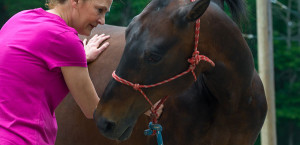What to Watch for During a Session
Each session lasts about an hour. Below are some things to watch for as the session unfolds.
 Tough Spots
Tough Spots
Ways horses tell me I may be getting to or have found a tough spot:
- overall restlessness
- stomping/pawing foot
- shaking head
- head bobbing head up and down
- attempting to move away from my hands
- ears turned towards me tells me they are paying attention to where I am and what I am doing
- grind teeth
- tail swish
- eyes become alert and watchful
Releasing Tension: Signs
 Ways horses let me know they have experienced a release of physical or emotional tension as I am working:
Ways horses let me know they have experienced a release of physical or emotional tension as I am working:
- lick and chew
- take a big breath
- yawn
- stretch- one did a cat stretch!
- fart/poop
- cough
- shake
- have a good roll after the massage
- blow their nose out
Show enjoyment by
- drop their head
- ears and eyes go soft or close
- geldings drop
- relax/take weight off a leg while I am working on a hip/rump
Hear it from Jodie:
Connecting
When I first meet a horse, I feel it is of utmost importance to connect with them. I usually begin by placing my hands on them and just “listen” for a bit. Get a feel for their body, and where they are at emotionally and physically. I like them to get a feel for me, my touch, my energy so we can connect. I let them know I am here for them and I am there to assist them in feeling better. This feeling of connection is important on many levels. It helps me anticipate when I am approaching a problem area by paying keen attention to their body language, both visually and physically.
Body Language
Understanding and paying attention to a horseʼs body language is a vital part of my work. Horse have very specific ways of communicating, some more subtle than others.
An ear turning softly towards me, lets me know they are paying attention to a sensation and are interested. An ear quickly swinging my way with a raising of the head tells me uh-oh, better watch where youʼre going! This is the first clue I am approaching a challenging spot. The communication may escalate to pinned ears, head bobbing up and down, tail swishing, pawing or doing their best to get away from me.
Paying Attention
It is very important that I pay attention and listen to this, yet it is equally important that I help the horse get through it. Many times the pain they remember or associate with an area, may actually be less in the present reality, when approached in the right manner. With the right touch, the horse begins to learn and feel that not only it is okay, it actually feels good to release some of the old tension. This can be a crucial part of the horseʼs education, and the beginning of building a trusting relationship.
Checking In
Most horses like to “check in” from time to time during the massage. Usually this is a casual muzzle to hand touch as they may be getting nervous about a spot. This reconnection is often enough to reassure them and they become willing to go on. This is one of the reasons I like to work with horses on a single tie, if possible. They have the freedom to communicate with me and to stretch and move as needed in order to facilitate a release during the massage. This is not always possible with horses that have only been handled on cross ties, but I like to give it a try initially.
After
After the massage it is best that the horse be allowed to move freely and have the rest of the day off from working. Some horses roll and are energetic, often times they nod off a bit and relax as they process the bodywork.
Changes to Look for
Changes in your horse may be very subtle at times. It might just be a change in attitude. They may be more relaxed overall, more willing to work even more affectionate. Depending on the initial issue, changes may be more obvious. They may be able to bend or flex a bit more, or able to get the correct lead with less difficulty. I did work with one horse that was able to lay down for the first time in almost a year, after 3 massages. As a competitor, that was a huge shift for that horse, to be able to finally be relaxed and get proper rest. She was much calmer during competitions and placed much higher in her classes.
A calmer more relaxed horse is better able to pay attention during training.

